Excerpts from Jim Conrad's
Naturalist Newsletter
entry from field notes dated June 28, 2022, taken in an oak forest on the slopes of Cerro de la Cruz, elevation ~2750m (~9000 ft), rising on the south side of the community of El Pinar, Amealco de Bonfil, Querétaro, MÉXICO, (~N20.17°, ~W100.17°)
BEAR CORN
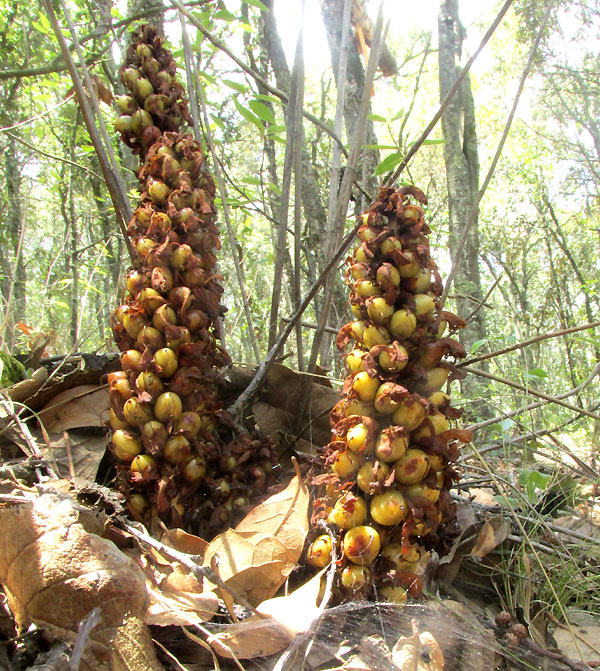
Emerging from the thick carpet of dry, leathery oak leaves covering the northern slope of Cerro de la Cruz, at this time of year during the early rainy season -- though this year the rains haven't come yet -- often you see what looks like blackened, disintegrating corncobs similar to what's shown above. Probably the subjects in the picture aren't blackened and falling apart because they matured later than all the others, which indeed nowadays are blackish and crumbly.
These items' strange form and color are so unusual that most forest-wanderers in eastern North America will recognize them as similar to something they may call Squawroot, Cancer Root or Bear Cone, and maybe they'll even know that this is a non-green, non-photosynthesizing, flowering plant that's fully parasitic on the roots of certain oak trees. The plants are members of the genus Conopholis, of the Broomrape Family, the Orobanchaceae. Conopholis is a small genus currently thought to include only three species, of which only one occurs in upland central Mexico.
That one species is CONOPHOLIS ALPINA, in English sometimes called Bear Corn because in the oak woodlands and mixed forests of mountainous Arizona, New Mexico and western Texas where this species occurs bears like to eat it. Other names for it include Groundcone, Alpine Cancer-root, Mexican Cancer-root and Alpine Squawroot. Bear Corn mostly occurs, however, throughout the Mexican uplands south into Honduras, and Spanish names for it indicate that other animals eat it, too: Elotes de Coyote (Coyote Corn), and Hierba del Venado (Deer Plant). Undoubtedly squirrels and other wild animals eat it as well, plus the country folk say that livestock feed on it gladly.
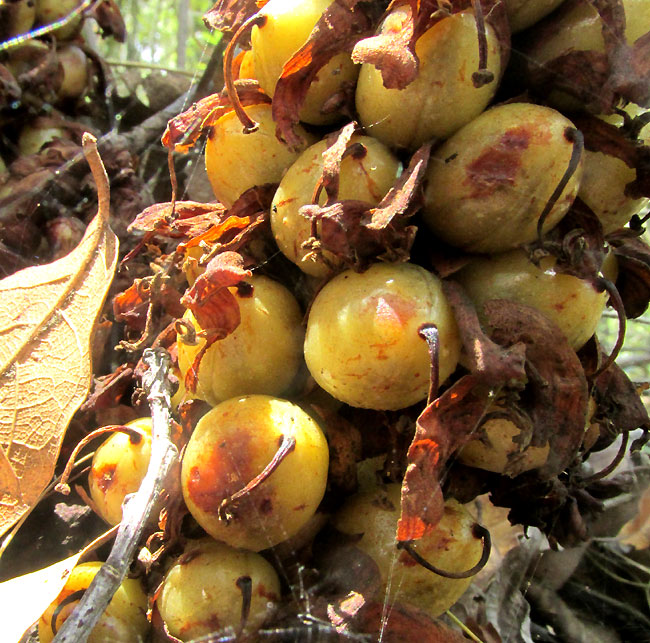
Above you see how Bear Corn's individual spherical fruits look a little like plump grains of corn on a cob. The slender, brown, stem-like items atop each fruit are the dried-up remains of the flower's style and knobby stigma. The yellowish-white, snapdragon-flower-like corollas have fallen off, but the dried, brown, tattered remains of the calyxes remain, issuing from between the fruits. Each fruit contains many small seeds which apparently pass intact through the intestines of critters who eat them.
Technically the plump fruits are classified by the Flora of North America as capsules which do not split open to release their seeds -- as "indehiscent." Normally capsular fruits are defined as dry fruits which split open when ripe, so here's another example of Nature not fitting humanity's precisely defined preconceptions.
In fact, even today with genetic sequencing revolutionizing plant taxonomy, the whole concept of the Broomrape Family, the Orobanchaceae, is still uncertain and debated. During my university days in the 1970s, the family incorporated only a relative handful of totally parasitic species containing no green chlorophyll at all.
However, today the family has been enlarged greatly to include many partially-parasitic species -- such as the Indian paintbrushes (Castilleja) and louseworts (Pedicularis) -- which produce green, photosynthesizing leaves while at the same time tapping into the root xylem of other plants to steal water, mineral nutrients, nitrogen and sometimes carbon. The fully parasitic species such as our Bear Corn, via their root-like haustoria, also tap into other plants' roots, but instead of xylem cells their haustoria penetrate the roots' phloem, thus stealing carbohydrates the victim has photosynthesized with its green parts. Even a few genera not at all parasitic have been added to the family, because their genes, but not their appearance, say they belong there.
John Slattery's 2020 book Southwest Medicinal Plants writes that all the bear corn, cancer root, broomrape species "heal burns and wounds, as well as induce a deep relaxation of the musculoskeletal and nervous systems." Tinctures of the whole plant are used. He reports that the Tarahumara of northern Mexico use Bear Corn during the birthing process.
Entry dated April 18, 2024, from notes taken about 1km north of Puerto de los Velazquez, Municipality of Pinal de Amoles; N21.1315°, -99.6703°, elevation ~2720 meters (~8900 feet); oak/pine forest on limestone bedrock; east-central Querétaro state, MÉXICO
A MESS OF BEAR CORN
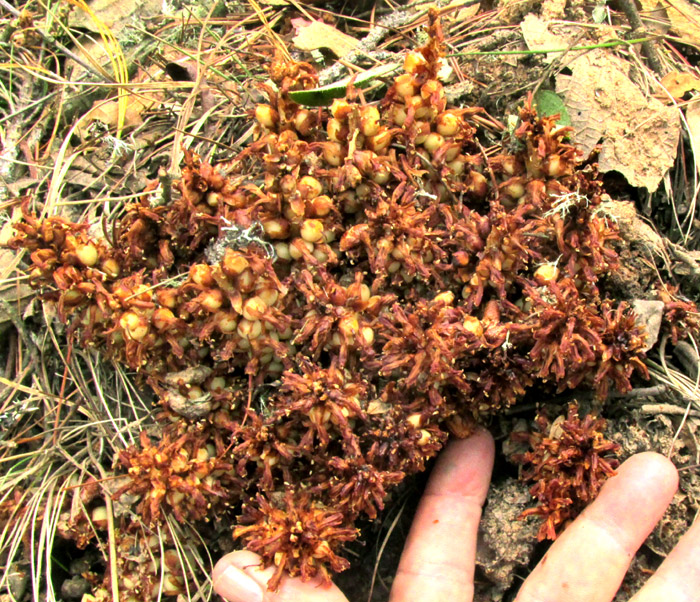
At first sight I thought the above was a heap of poop from a bear who had been eating ripe corn, but then I remembered that here bears were killed off a long time ago. Up close, it was clear we had a colony of flowering plants:
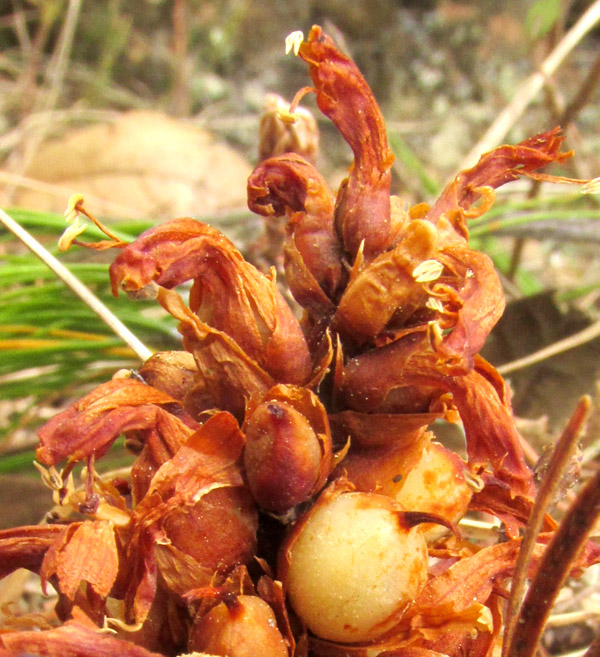
The above shows the top of one of numerous crowded, flower-bearing stems. At the picture's top, one flower's curved, tubular corolla is directed skyward. The corolla is drying out, with its fresh yellowish color turning dark orangish brown. The corolla base arises from inside a goblet-shaped calyx crowned with short sepals.

The above image features a single curving, brittle and disintegrating corolla from which two of the flower's four stamens emerge bearing white, two-chambered anthers. The extended stamens are good field marks because a fairly similar species in the same family occurs in this area, Orobanche dugesii, but its stamens usually do not pass beyond the corolla mouth.
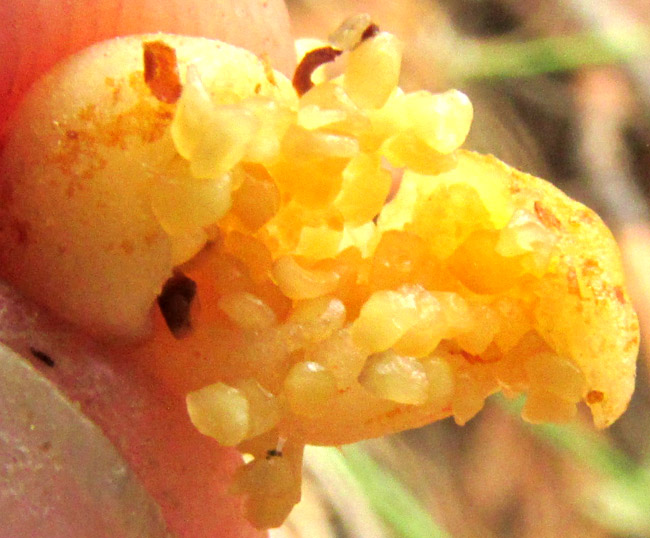
The first picture in this entry shows pale yellow, spherical, corn-grain like items strewn within the dark brown mess. Those are capsular-type fruits, and the above picture shows one of those fruits split open to reveal numerous oval, cream-colored seeds.

At the right you see part of a fruiting head from last season. The individual capsules have dispersed their seeds through irregular openings in their coverings instead of through neat sutures, which is more typical. I wonder if such a dissemination strategy encourages animals such as rodents and possibly birds to open them and distribute the seeds they don't digest? This could be a more efficient process than just dumping the seeds onto the ground at a certain season.
So, here we have another appearance which Bear Corn can assume -- lots of stems clustered together, and the stems still bearing flowers with corollas, albeit the flowers are past-prime, drying-out ones turning brown.
As non-chlorophyll-bearing, obligate parasites, our plants can't live without robbing their water and nutrients from a "host," which with Bear Corn is an oak tree. Instead of possessing roots, Bear Corn stem bases develop somewhat woody, tuberlike underground structures which attach directly to an oak tree's root. These structures produce rootlike haustoria which penetrate the oak root's vascular tissue, and draw off water and nutrients being conducted upward into the oak tree.
Nature seems to be agreeable to the parasitism idea. The 2021 study by Luiza Teixeira-Costa and Charles Davis entitled "Life history, diversity, and distribution in parasitic flowering plants," tells us that throughout evolutionary history, 12 times such parasitism independently has arisen among several families of flowering plants. The resulting parasitic species account for 1% of all flowering species.